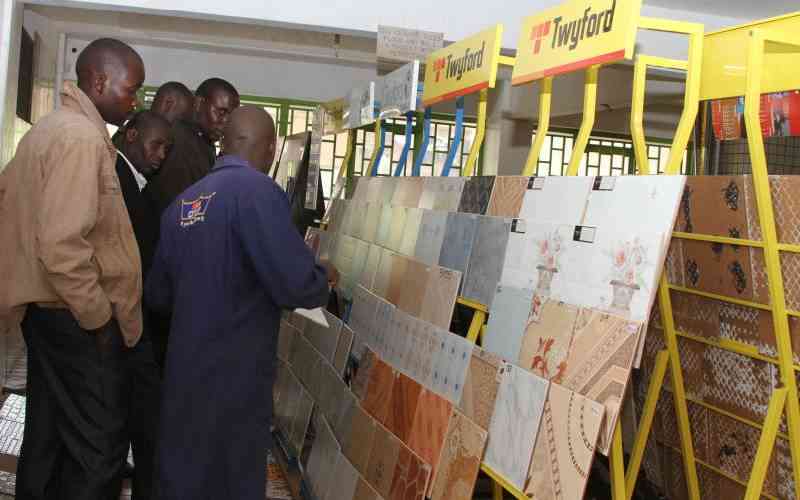
Kenyans are gradually moving away from the days when every shilling they earned went to silencing the raging rumbles of their empty stomachs.
A look at how consumers spend Sh1,000 today against how they spent it 10 years ago shows a general shift in the amount that goes towards satisfying the traditional basic needs of food, shelter and clothing.
Now, communication and dining out are being found increasingly worthy of people’s cash, an analysis of data from the Kenya National Bureau of Statistics (KNBS) shows.
With increased earnings over the past decade, a growing number of Kenyans can comfortably purchase the essentials and still have enough left over to educate or entertain themselves.
An improved standard of living is cheaper to attain today than it was 10 years ago. However, by global standards, food still takes up an overly large chunk of Kenyans’ income — more than a third of money spent goes to food.
It is worse for the poor in Nairobi for whom out of every Sh5 spent, Sh2 goes to buying food. For the rich in the city, food accounts for just about half of this amount, or 17 per cent of their income. This rich-poor divide in Nairobi when it comes to food is replicated across the country.
Generally speaking, the more developed a country is, the smaller the percentage of household income it spends on food. Americans, for example, spend just 6.4 per cent of their income on food, according to the US Department of Agriculture (USDA).
Improved standards
However, an analysis of the latest consumer price index (CPI), which is a cost of living measure prepared by KNBS, shows that the standard of living among Kenyans has been improving.
Compared to 10 years ago, fewer Kenyans are living from hand to mouth. Further, many of them are spending less of their hard-earned income on food, rent, clothes and shoes, or even lighting, house maintenance, cooking fuel and health.
In 2010, a typical Kenyan consumer would spend close to 70 per cent of their income on food and non-alcoholic beverages to nourish their bodies.
Clothes, shoes and rent would take up another sizeable chunk of cash as they sought to insulate themselves from the vagaries of nature, such as cold, rain and heat.
Things have since changed. Today, just slightly over half of their income is spent on what American psychologist Abraham Maslow described as physiological needs.
This has left consumers with more disposable income to spend on education, buy airtime and data bundles for communication, hail a taxi online or boda boda, enjoy a night at the club or pay for a cup of coffee at a café.
Stay informed. Subscribe to our newsletter
Lowering the amount that Kenyans spend on food is one of the drivers behind President Uhuru Kenyatta’s Big Four Agenda. One of its pillars is to ensure citizens enjoy food security and improved nutrition by 2022 by boosting production, and thus bringing food costs down.
This, the government hopes, will see the cost of food as percentage of people’s incomes drop from a high of 47 per cent in 2017 to 25 per cent in 2022.
As it stands, however, the biggest change in spending habits has been the share of cash that goes towards buying clothes and shoes.
Today, this takes up Sh30 for every Sh1,000 that a typical Kenyan spends – a drop of 60 per cent from the Sh74 that these items gobbled up 10 years ago.
Household maintenance — which includes buying furniture, washing carpets, fixing a sink or buying TV set or radio — has also registered a decline of 50 per cent, taking up Sh31 out of Sh1,000 compared to Sh62 a decade ago.
Further, thanks to medical schemes such as the National Hospital Insurance Fund (NHIF) as well as a proliferation of small hospitals around the country, the share of money going towards medication has dropped to Sh19, a dip of 39 per cent from Sh31 in 2010.
A survey on financial inclusion by the Central Bank of Kenya, KNBS and FSD Kenya showed that the fraction of the population with NHIF cover had gone up from 4.2 per cent in 2009 to 26.1 per cent in 2019.
“Government policy initiatives on universal healthcare together with other policy measures led to increased usage of NHIF ... almost doubling of the usage of insurance services,” read part of the report.
Rent, water and electricity are still a big cost burden for most households, but these items are taking up less of people’s incomes, with the average household putting Sh146 into these items from Sh1,000 compared to Sh180 just 10 years ago.
Data bundles
The data illustrates that as a share of total income, the basics are not taking up as much money as they did a decade ago. This has allowed consumers to pump the extra cash into communication, restaurants and hotels, personal care and social welfare, and education.
In fact, airtime, data bundles and mobile money transfer services have come to occupy a special place in the shopping basket of the average Kenyan.
After the review of the CPI by KNBS this year, airtime is now the single item that takes up biggest chunk of income.
After the review of the goods and services used to compile the index, KNBS gave airtime a weight of 5.496, the largest of any single consumer product.
Kenyans are putting more of their money into airtime than even rent – which had the heaviest weight just three years ago – health or education.
Airtime not only powers voice calls and text messages, it also enables communication on social media platforms such as WhatsApp, Facebook, Instagram, YouTube and Twitter.
Transport is another area that has benefited from the surplus income in Kenyans’ pockets after spending on the three basic needs declined. The review of the CPI by KNBS showed matatu fare is the second weightiest consumer item in the new basket.
 The Standard Group Plc is a
multi-media organization with investments in media platforms spanning newspaper
print operations, television, radio broadcasting, digital and online services. The
Standard Group is recognized as a leading multi-media house in Kenya with a key
influence in matters of national and international interest.
The Standard Group Plc is a
multi-media organization with investments in media platforms spanning newspaper
print operations, television, radio broadcasting, digital and online services. The
Standard Group is recognized as a leading multi-media house in Kenya with a key
influence in matters of national and international interest.
 The Standard Group Plc is a
multi-media organization with investments in media platforms spanning newspaper
print operations, television, radio broadcasting, digital and online services. The
Standard Group is recognized as a leading multi-media house in Kenya with a key
influence in matters of national and international interest.
The Standard Group Plc is a
multi-media organization with investments in media platforms spanning newspaper
print operations, television, radio broadcasting, digital and online services. The
Standard Group is recognized as a leading multi-media house in Kenya with a key
influence in matters of national and international interest.










